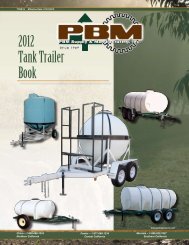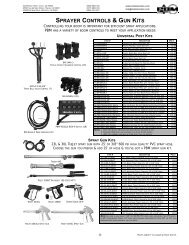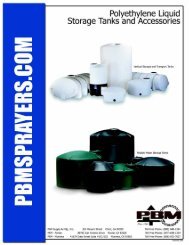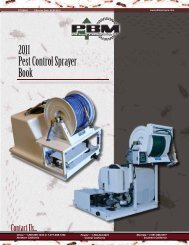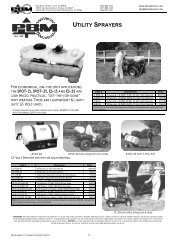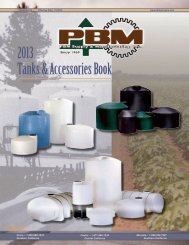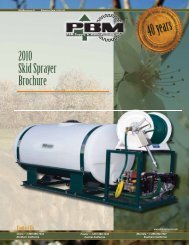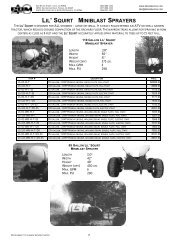2009 HAV 300 Owner's Manual - PBM Supply & Mfg.
2009 HAV 300 Owner's Manual - PBM Supply & Mfg.
2009 HAV 300 Owner's Manual - PBM Supply & Mfg.
You also want an ePaper? Increase the reach of your titles
YUMPU automatically turns print PDFs into web optimized ePapers that Google loves.
www.pbmsprayers.com<br />
<strong>HAV</strong> <strong>300</strong> Series<br />
Other <strong>HAV</strong> <strong>300</strong> Required Service<br />
Air Conditioning:<br />
1. Check the air conditioning condenser for excessive build-up of dirt, leaves, etc., in the<br />
cooling fi ns. Blow out the condenser on a regular basis to ensure adequate air-fl ow<br />
through the fi ns.<br />
2. Check the air conditioning compressor drive belts and tighten as necessary. The<br />
adjuster is located on the bottom side of the compressor. Tighten the belts until there is<br />
enough play to twist the belts one quarter turn.<br />
Spray Pump (Hypro ® ):<br />
1. The spray pump must be fl ushed to prevent “gumming” or corrosion inside the pump.<br />
To do this, simply fl ush the pump with a solution that will neutralize any liquid<br />
mixed according to the manufacturer’s directions.<br />
2. After cleaning the pump, fl ush it with a 50% solution of permanent type automobile<br />
anti-freeze containing a rust inhibitor and water. A rust inhibitor such as Fluid Film<br />
(item number 2160-0010) can also be squirted into the ports of the pump. Turn the shaft<br />
several times to draw the protective liquid through the pump and coat the entire surface.<br />
Drain the pump and plug ports to keep out air during storage. For short periods of<br />
idleness, non-corrosive liquids may be left in the pump, but air MUST be kept out. Plug<br />
the ports or seal port connections.<br />
Spray Control Systems (Raven ® ):<br />
1. Flush the entire system with water after use of suspension type chemicals. Failure to<br />
clean the system can result in crystallization of chemicals which may plug the fl ow<br />
meter, lines, and / or tips.<br />
2. Flush and drain the sprayer before storing. Freezing temperatures may damage the fl ow<br />
meter if water is not entirely drained.<br />
3. Remove the fl ow meter at the end of each spraying season. Clean the fl ow meter<br />
turbine and inlet hub. Clean off all metal fi lings and wettable powders which have<br />
hardened on the plastic and metal parts. Check the inlet hub and turbine assembly for<br />
worn or damaged turbine blades and bearings.<br />
4. Remove the console from the cab when not in use for extended periods to prevent the<br />
batteries from discharging.<br />
Rear Axle Differential Service:<br />
1. To check the fl uid levels in the rear axle differential, remove the square head pipe plug<br />
located in the center of the rear cover on the axle differential using a 5/8 inch open end<br />
wrench or a crescent wrench.<br />
2. The recommended fl uid change in the rear axle differential for the <strong>HAV</strong> <strong>300</strong> is every 12<br />
months. If the axles become submerged in water at ANY time, the differential fl uid must<br />
be drained immediately, and the vehicle serviced at that time. Use SAE 90WT<br />
multi-purpose Gear Lube, meeting Mil. Spec. L-2105-B or 80W90, meeting API service<br />
classifi cation GL-5 as a minimum requirement. Use one four ounce tube of Sta-Lube<br />
brand Equa-Torque limited slip additive when changing the differential fl uid.<br />
Preparing the <strong>HAV</strong> <strong>300</strong> for Storage<br />
Kubota ® Diesel Engine<br />
Before storing he engine for more than a few months, clean the machine thoroughly and do<br />
ALL of the following:<br />
1. Drain the radiator coolant. Replace with new 50/50 antifreeze coolant.<br />
Since water may freeze when the temperatures drop below 32 O F (0 O C), it is very<br />
important that an antifreeze solution is left in the machine.<br />
2. Remove any dirty engine oil and fi ll with new oil. Run the engine for about fi ve minutes<br />
to allow the oil to penetrate to all the parts.<br />
3. Check all the bolts and nuts and tighten (if necessary).<br />
4. Remove the battery from the engine. Recharge it and adjust the electrolyte level. Store<br />
the battery in a dry / dark place. *When the engine is not used for a long period of time,<br />
run it for about fi ve minutes under “no load” conditions every 2-3 months to keep it free<br />
from rust. If the engine is stored without this running method, condensation from the air<br />
may cause rust on sliding parts of the engine. **If the engine is not run for longer than<br />
5-6 months, apply oil to the valve guide and valve stem sealing and make sure the valve<br />
works smoothly before starting the engine.<br />
10<br />
Chico ~ 1-800-688-1334<br />
Northern California<br />
Fowler ~ 1-877-688-1334<br />
Central California<br />
Murrieta ~ 1-866-922-7627<br />
Southern California




